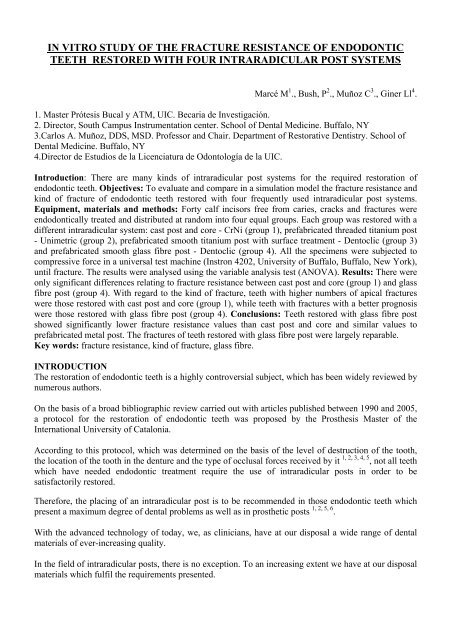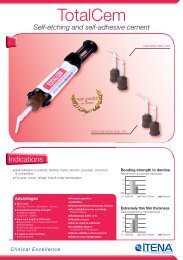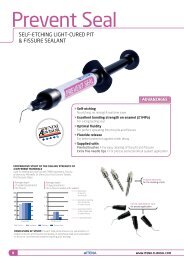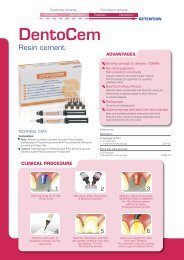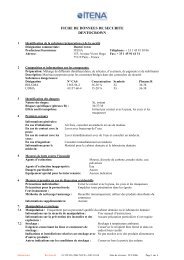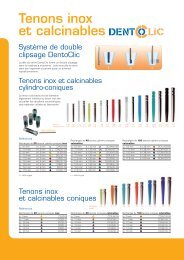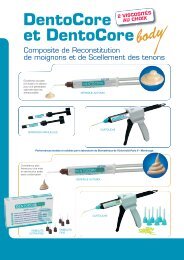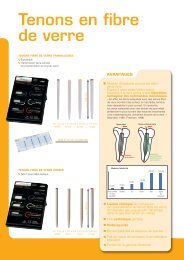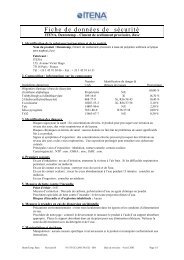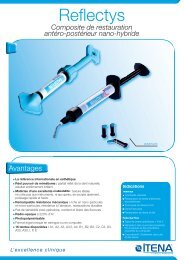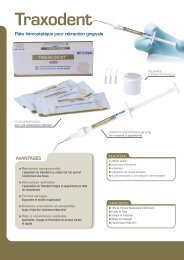in vitro study of the fracture resistance of endodontic teeth restored ...
in vitro study of the fracture resistance of endodontic teeth restored ...
in vitro study of the fracture resistance of endodontic teeth restored ...
You also want an ePaper? Increase the reach of your titles
YUMPU automatically turns print PDFs into web optimized ePapers that Google loves.
IN VITRO STUDY OF THE FRACTURE RESISTANCE OF ENDODONTIC<br />
TEETH RESTORED WITH FOUR INTRARADICULAR POST SYSTEMS<br />
Marcé M 1 ., Bush, P 2 ., Muñoz C 3 ., G<strong>in</strong>er Ll 4 .<br />
1. Master Prótesis Bucal y ATM, UIC. Becaria de Investigación.<br />
2. Director, South Campus Instrumentation center. School <strong>of</strong> Dental Medic<strong>in</strong>e. Buffalo, NY<br />
3.Carlos A. Muñoz, DDS, MSD. Pr<strong>of</strong>essor and Chair. Department <strong>of</strong> Restorative Dentistry. School <strong>of</strong><br />
Dental Medic<strong>in</strong>e. Buffalo, NY<br />
4.Director de Estudios de la Licenciatura de Odontología de la UIC.<br />
Introduction: There are many k<strong>in</strong>ds <strong>of</strong> <strong>in</strong>traradicular post systems for <strong>the</strong> required restoration <strong>of</strong><br />
<strong>endodontic</strong> <strong>teeth</strong>. Objectives: To evaluate and compare <strong>in</strong> a simulation model <strong>the</strong> <strong>fracture</strong> <strong>resistance</strong> and<br />
k<strong>in</strong>d <strong>of</strong> <strong>fracture</strong> <strong>of</strong> <strong>endodontic</strong> <strong>teeth</strong> <strong>restored</strong> with four frequently used <strong>in</strong>traradicular post systems.<br />
Equipment, materials and methods: Forty calf <strong>in</strong>cisors free from caries, cracks and <strong>fracture</strong>s were<br />
<strong>endodontic</strong>ally treated and distributed at random <strong>in</strong>to four equal groups. Each group was <strong>restored</strong> with a<br />
different <strong>in</strong>traradicular system: cast post and core - CrNi (group 1), prefabricated threaded titanium post<br />
- Unimetric (group 2), prefabricated smooth titanium post with surface treatment - Dentoclic (group 3)<br />
and prefabricated smooth glass fibre post - Dentoclic (group 4). All <strong>the</strong> specimens were subjected to<br />
compressive force <strong>in</strong> a universal test mach<strong>in</strong>e (Instron 4202, University <strong>of</strong> Buffalo, Buffalo, New York),<br />
until <strong>fracture</strong>. The results were analysed us<strong>in</strong>g <strong>the</strong> variable analysis test (ANOVA). Results: There were<br />
only significant differences relat<strong>in</strong>g to <strong>fracture</strong> <strong>resistance</strong> between cast post and core (group 1) and glass<br />
fibre post (group 4). With regard to <strong>the</strong> k<strong>in</strong>d <strong>of</strong> <strong>fracture</strong>, <strong>teeth</strong> with higher numbers <strong>of</strong> apical <strong>fracture</strong>s<br />
were those <strong>restored</strong> with cast post and core (group 1), while <strong>teeth</strong> with <strong>fracture</strong>s with a better prognosis<br />
were those <strong>restored</strong> with glass fibre post (group 4). Conclusions: Teeth <strong>restored</strong> with glass fibre post<br />
showed significantly lower <strong>fracture</strong> <strong>resistance</strong> values than cast post and core and similar values to<br />
prefabricated metal post. The <strong>fracture</strong>s <strong>of</strong> <strong>teeth</strong> <strong>restored</strong> with glass fibre post were largely reparable.<br />
Key words: <strong>fracture</strong> <strong>resistance</strong>, k<strong>in</strong>d <strong>of</strong> <strong>fracture</strong>, glass fibre.<br />
INTRODUCTION<br />
The restoration <strong>of</strong> <strong>endodontic</strong> <strong>teeth</strong> is a highly controversial subject, which has been widely reviewed by<br />
numerous authors.<br />
On <strong>the</strong> basis <strong>of</strong> a broad bibliographic review carried out with articles published between 1990 and 2005,<br />
a protocol for <strong>the</strong> restoration <strong>of</strong> <strong>endodontic</strong> <strong>teeth</strong> was proposed by <strong>the</strong> Pros<strong>the</strong>sis Master <strong>of</strong> <strong>the</strong><br />
International University <strong>of</strong> Catalonia.<br />
Accord<strong>in</strong>g to this protocol, which was determ<strong>in</strong>ed on <strong>the</strong> basis <strong>of</strong> <strong>the</strong> level <strong>of</strong> destruction <strong>of</strong> <strong>the</strong> tooth,<br />
<strong>the</strong> location <strong>of</strong> <strong>the</strong> tooth <strong>in</strong> <strong>the</strong> denture and <strong>the</strong> type <strong>of</strong> occlusal forces received by it 1, 2, 3, 4, 5 , not all <strong>teeth</strong><br />
which have needed <strong>endodontic</strong> treatment require <strong>the</strong> use <strong>of</strong> <strong>in</strong>traradicular posts <strong>in</strong> order to be<br />
satisfactorily <strong>restored</strong>.<br />
Therefore, <strong>the</strong> plac<strong>in</strong>g <strong>of</strong> an <strong>in</strong>traradicular post is to be recommended <strong>in</strong> those <strong>endodontic</strong> <strong>teeth</strong> which<br />
present a maximum degree <strong>of</strong> dental problems as well as <strong>in</strong> pros<strong>the</strong>tic posts 1, 2, 5, 6 .<br />
With <strong>the</strong> advanced technology <strong>of</strong> today, we, as cl<strong>in</strong>icians, have at our disposal a wide range <strong>of</strong> dental<br />
materials <strong>of</strong> ever-<strong>in</strong>creas<strong>in</strong>g quality.<br />
In <strong>the</strong> field <strong>of</strong> <strong>in</strong>traradicular posts, <strong>the</strong>re is no exception. To an <strong>in</strong>creas<strong>in</strong>g extent we have at our disposal<br />
materials which fulfil <strong>the</strong> requirements presented.
The majority <strong>of</strong> authors 1, 7, 8, 9, 10, 11 opt for prefabricated fibre re<strong>in</strong>forced posts <strong>in</strong>stead <strong>of</strong> traditional cast<br />
post and cores and prefabricated metal posts, featur<strong>in</strong>g high rigidity, low aes<strong>the</strong>tic value, easy corrosion<br />
and factures <strong>of</strong> largely irreparable character 1, 6, 8 .<br />
For prefabricated fibre re<strong>in</strong>forced posts, <strong>the</strong>re is a wide range <strong>of</strong> fibre materials, namely glass fibres,<br />
be<strong>in</strong>g one <strong>of</strong> those considered to be better by some authors 8, 11 . They have an elastic module similar to<br />
dent<strong>in</strong> and can <strong>the</strong>refore transmit occlusal forces <strong>in</strong> a uniform way. They also feature good aes<strong>the</strong>tic<br />
value, absence <strong>of</strong> corrosion, adhesive cementation and easy removal if needed 1, 8, 12, 13 .<br />
Even so, some cl<strong>in</strong>icians are still reluctant to opt for glass fibre posts, perhaps due to <strong>the</strong> lack <strong>of</strong> longterm<br />
research <strong>in</strong>to this subject.<br />
The literature shows that <strong>the</strong>re is a correlation between <strong>the</strong> <strong>fracture</strong> <strong>resistance</strong> <strong>of</strong> a tooth and <strong>the</strong> rigidity<br />
<strong>of</strong> a post. Posts which exhibit similar rigidity to that <strong>of</strong> dent<strong>in</strong> will enhance <strong>the</strong> uniform distribution <strong>of</strong><br />
occlusal forces across <strong>the</strong> post and <strong>the</strong> root, decreas<strong>in</strong>g <strong>the</strong> level <strong>of</strong> susceptibility to coronoradicular<br />
11, 14, 15<br />
<strong>fracture</strong>s<br />
The objectives <strong>of</strong> this <strong>in</strong> <strong>vitro</strong> <strong>study</strong> are <strong>the</strong> evaluation and comparison, <strong>in</strong> a simulation model, <strong>of</strong> <strong>the</strong><br />
<strong>fracture</strong> <strong>resistance</strong> and <strong>the</strong> type <strong>of</strong> <strong>fracture</strong> <strong>of</strong> <strong>endodontic</strong> <strong>teeth</strong> <strong>restored</strong> by means <strong>of</strong> four <strong>in</strong>traradicular<br />
post systems which are frequently used, <strong>in</strong>clud<strong>in</strong>g a glass fibre post.<br />
EQUIPMENT, MATERIALS AND METHODS<br />
In order to complete this <strong>in</strong> <strong>vitro</strong> <strong>study</strong>, forty lateral calf <strong>in</strong>cisors free from caries, cracks and <strong>fracture</strong>s<br />
were selected for <strong>the</strong> purpose <strong>of</strong> <strong>endodontic</strong>ally treat<strong>in</strong>g <strong>the</strong>m and restor<strong>in</strong>g <strong>the</strong>m us<strong>in</strong>g four different<br />
<strong>in</strong>traradicular post systems: cast post and core system (CrNi), threaded titanium post (Unimétric ® ),<br />
smooth titanium post with surface treatment (Dentoclic ® . Gacd, Promodentaire, Dentoria) and a glass<br />
fibre post (Dentoclic ® . Gacd, Promodentaire, Dentoria).<br />
The <strong>teeth</strong> were chosen <strong>in</strong> such a way that <strong>the</strong>y all presented maximum similarity with regard to <strong>the</strong>ir<br />
length and breadth (Photo 1). They were carefully cleaned to remove perirradicular tissue us<strong>in</strong>g a scrap<strong>in</strong>g<br />
curette and root-smooth<strong>in</strong>g device No. 13/14 and were stored <strong>in</strong> sal<strong>in</strong>e solution at ambient temperature<br />
until undergo<strong>in</strong>g <strong>the</strong> <strong>study</strong>.<br />
(Photo 1)<br />
In order to make <strong>the</strong> dimensions uniform, <strong>the</strong> dental pieces were each cut to 23 mm from <strong>the</strong> apex by<br />
means <strong>of</strong> a horizontal cut relative to <strong>the</strong> axial axis, to elim<strong>in</strong>ate <strong>the</strong> anatomical crown, us<strong>in</strong>g a 40,000<br />
rpm hand-held disc under aqueous refrigeration (Photo 2)<br />
(Photo 2)
The radicular canals <strong>of</strong> all <strong>the</strong> <strong>teeth</strong> were prepared <strong>endodontic</strong>ally with <strong>the</strong> Pr<strong>of</strong>ile rotary system us<strong>in</strong>g<br />
<strong>the</strong> Crown-Down technique.<br />
Firstly, <strong>the</strong> <strong>endodontic</strong> access was prepared us<strong>in</strong>g Gates Glidden drills (Maillefer ® ) No. 2, 3 and 4, at 5,<br />
7 and 9mm from <strong>the</strong> apex respectively. Then came <strong>the</strong> K-files (Dentsplay. Maillefer) Nos. 10 to 20 and<br />
<strong>the</strong> canals were manipulated us<strong>in</strong>g Pr<strong>of</strong>ile ® files up to a work<strong>in</strong>g length <strong>of</strong> 22mm with a 40 calibre,<br />
while irrigation was <strong>in</strong>troduced with sodium hypochlorite at 2.5%. Once <strong>the</strong> canals had been prepared,<br />
<strong>the</strong>y were dried and filled. In order to dry <strong>the</strong> canals, paper po<strong>in</strong>ts (Roeko ® ) and pressurised air were<br />
used. Fill<strong>in</strong>g took place manually with lateral condensation us<strong>in</strong>g a digital condenser and gutta-percha<br />
covered with cement (AH-Plus ® , Dentsplay DeTrey) free from eugenol.<br />
The filled <strong>teeth</strong> were divided at random <strong>in</strong>to four equal groups so that <strong>the</strong>re were 10 examples per group.<br />
Each group was <strong>restored</strong> us<strong>in</strong>g one <strong>of</strong> <strong>the</strong> four <strong>in</strong>traradicular systems to be studied: (Photo 3)<br />
Group 1: cast post and core (CrNi).<br />
Group 2: threaded titanium post (Unimetric ® . Maillefer)<br />
Group 3: smooth titanium post with surface treatment (Dentoclic ® . Gacd, Promodentaire, Dentoria).<br />
Group 4: glass fibre post (Dentoclic ® . Gacd, Promodentaire, Dentoria).<br />
(Photo 3)<br />
Group 1 Group 2 Group 3 Group 4<br />
To maximally standardise <strong>the</strong> cemented area <strong>of</strong> <strong>the</strong> prefabricated posts and <strong>the</strong> cast posts, <strong>the</strong> radicular<br />
canals <strong>of</strong> <strong>the</strong> different groups were all prepared at 15mm except those <strong>of</strong> <strong>the</strong> second group (Unimetric ® .<br />
Maillefer). These were prepared at 1 mm less (14mm) because <strong>of</strong> <strong>the</strong>ir length. In this way it is not<br />
necessary to cut <strong>the</strong> post-head, <strong>the</strong>reby not alter<strong>in</strong>g its properties. The gutta-percha <strong>of</strong> <strong>the</strong> canals was<br />
elim<strong>in</strong>ated firstly us<strong>in</strong>g Gates Glidden drills No. 2, 3 and 4, followed by <strong>the</strong> special drills for preparation<br />
<strong>of</strong> each post kit. At least 5 mm <strong>of</strong> <strong>the</strong> apical gutta-percha was preserved to ma<strong>in</strong>ta<strong>in</strong> <strong>the</strong> <strong>endodontic</strong> seal<br />
at <strong>the</strong> apical level.<br />
The production <strong>of</strong> <strong>the</strong> 10 cast post and cores belong<strong>in</strong>g to <strong>the</strong> first group was completed us<strong>in</strong>g an alloy<br />
<strong>of</strong> Cr-Ni with <strong>in</strong>direct technique by means <strong>of</strong> calc<strong>in</strong>able plastic posts and silicone type impression<br />
addition material <strong>of</strong> medium and fluid consistency.<br />
All <strong>the</strong> posts were cemented with <strong>the</strong> latest generation res<strong>in</strong>ous cement (Rely X Unicem, 3M) accord<strong>in</strong>g<br />
to <strong>the</strong> manufacturer’s recommendations.
For <strong>the</strong> cement<strong>in</strong>g <strong>of</strong> <strong>the</strong> <strong>in</strong>traradicular systems <strong>of</strong> <strong>the</strong> first three groups it was not necessary to complete<br />
any type <strong>of</strong> additional preparation <strong>of</strong> <strong>the</strong> radicular canals or <strong>of</strong> <strong>the</strong> surface <strong>of</strong> <strong>the</strong> systems, as <strong>in</strong>dicated by<br />
<strong>the</strong> manufacturer.<br />
The glass fibre posts (Dentoclic. Gacd, Promodentaire, Dentoria), which belong to group 4, were<br />
prepared accord<strong>in</strong>g to <strong>the</strong> manufacturer’s recommendations. Silane (Monobond-S) was applied to <strong>the</strong>ir<br />
surface and left to take effect for 60 seconds and <strong>the</strong> surface was <strong>the</strong>n dried with air.<br />
The dual self-etch<strong>in</strong>g cement Rely X Unicem was mixed accord<strong>in</strong>g to <strong>the</strong> manufacturer’s<br />
recommendations for 12 seconds us<strong>in</strong>g <strong>the</strong> Rotomix.<br />
All <strong>the</strong> posts were covered with a f<strong>in</strong>e coat<strong>in</strong>g <strong>of</strong> Rely X Unicem and were <strong>in</strong>serted <strong>in</strong> a passive way,<br />
with pressure exerted by <strong>the</strong> f<strong>in</strong>ger, <strong>in</strong>to <strong>the</strong> dry radicular canals as far as <strong>the</strong> length established.<br />
Subsequently <strong>the</strong> surplus was removed and each specimen was polymerised for 40 seconds us<strong>in</strong>g a<br />
halogen lamp for photo-polymerisation.<br />
To reconstruct <strong>the</strong> cores <strong>of</strong> groups 2, 3 and 4 a hybrid composite was used (Tetric Ceram). For <strong>the</strong><br />
condition<strong>in</strong>g <strong>of</strong> <strong>the</strong> dental structure, <strong>the</strong> surfaces <strong>of</strong> <strong>the</strong> <strong>teeth</strong> were etched with phosphoric acid at 37%<br />
for 15 seconds, followed by wash<strong>in</strong>g with abundant aqueous solution, dry<strong>in</strong>g and dual adhesive<br />
application (Excite), which was polymerised for 20 seconds. Then, <strong>the</strong> restorative material was applied<br />
<strong>in</strong> layers, be<strong>in</strong>g polymerised for periods <strong>of</strong> 40 seconds (lamp mark), until a core with appropiate<br />
dimensions was obta<strong>in</strong>ed.<br />
In order to achieve a ferrule effect <strong>in</strong> <strong>the</strong> 40 specimens <strong>the</strong> dental marg<strong>in</strong>s were cut to 2mm apical <strong>of</strong> <strong>the</strong><br />
most coronal zone <strong>of</strong> <strong>the</strong> root. Therefore 2mm <strong>of</strong> <strong>in</strong>ternal dental structure rema<strong>in</strong>ed above <strong>the</strong> marg<strong>in</strong> <strong>in</strong><br />
<strong>the</strong> vertical sense, <strong>in</strong> <strong>the</strong> form <strong>of</strong> a ferrule.<br />
Impressions were taken <strong>of</strong> <strong>the</strong> cores cut with monophase addition silicone <strong>in</strong> order to prepare metal caps<br />
<strong>of</strong> Cr-Ni, which were subsequently cemented to <strong>the</strong> cores, also with Rely X Unicem, 3M cement. In <strong>the</strong><br />
same way, a horizontal groove was made <strong>in</strong> each cap on <strong>the</strong> palatal side, by simulat<strong>in</strong>g <strong>the</strong> po<strong>in</strong>t <strong>of</strong><br />
<strong>in</strong>ter<strong>in</strong>cisive fixation, with a low-revolution, hand-held disc drill, with abundant aqueous refrigeration.<br />
Next, a sampl<strong>in</strong>g cup with <strong>the</strong> dimensions <strong>of</strong> 10 x 10 x 26mm was shaped with photopolymerisable<br />
acrylic res<strong>in</strong> (Triad ® ) and was photocured <strong>in</strong> <strong>the</strong> photopolymerisation mach<strong>in</strong>e (Triad ® ) for 30 seconds.<br />
Us<strong>in</strong>g this model, a standardised template was made with condensation silicone (Optosil ® ), which was<br />
used for <strong>the</strong> preparation <strong>of</strong> <strong>the</strong> 40 sampl<strong>in</strong>g cups, <strong>in</strong>to which <strong>the</strong> <strong>teeth</strong> were <strong>in</strong>serted, leav<strong>in</strong>g 2mm <strong>of</strong> <strong>the</strong><br />
coronal free. These were also photocured for 10 seconds each.<br />
Before be<strong>in</strong>g studied <strong>in</strong> <strong>the</strong> laboratories <strong>of</strong> <strong>the</strong> University <strong>of</strong> Buffalo, all <strong>the</strong> specimens were stored for a<br />
week <strong>in</strong> aqueous solution at 35ºC.<br />
Once <strong>the</strong> samples had arrived <strong>in</strong> Buffalo (University <strong>of</strong> Buffalo, South Campus, Buffalo, New York,<br />
USA), <strong>the</strong> sampl<strong>in</strong>g cups manufactured <strong>in</strong> Barcelona (International University <strong>of</strong> Catalonia, Sant Cugat,<br />
Barcelona, Spa<strong>in</strong>) were adapted to <strong>the</strong> dimensions required with auto-polymerisable acrylic res<strong>in</strong><br />
(Bosworth fastray TM ® ), to be subsequently fixed by mach<strong>in</strong>e (Photo 4).
(Photo 4)<br />
The forty samples were subjected to a progressive s<strong>in</strong>gle compressive force <strong>in</strong> Knewtons, us<strong>in</strong>g a<br />
universal test mach<strong>in</strong>e (Instron 4202, University <strong>of</strong> Buffalo, Buffalo, New York, USA) (Photo 5), at a<br />
constant speed <strong>of</strong> 5mm/m<strong>in</strong>, under conditions <strong>of</strong> 50% humidity and a uniform temperature <strong>of</strong> 72ºF until<br />
fractur<strong>in</strong>g occurred. The compressive force was applied with a po<strong>in</strong>ter, which rested on <strong>the</strong> groove made<br />
<strong>in</strong> <strong>the</strong> caps at an angle <strong>of</strong> 135º relative to <strong>the</strong> longitud<strong>in</strong>al axis <strong>of</strong> <strong>the</strong> <strong>teeth</strong>. For this, an autopolymerisable<br />
acrylic res<strong>in</strong> ramp (Bosworth fastray TM ® ) <strong>of</strong> 45º was made, this be<strong>in</strong>g placed below <strong>the</strong><br />
sample fix<strong>in</strong>g device, result<strong>in</strong>g <strong>in</strong> an angle <strong>of</strong> 135º between <strong>the</strong> sample and <strong>the</strong> po<strong>in</strong>ter (Photo 6).<br />
(Photo 5) (Photo 6)<br />
In order to determ<strong>in</strong>e <strong>the</strong> type <strong>of</strong> <strong>fracture</strong> <strong>of</strong> <strong>the</strong> specimens tested, radiographs were taken <strong>of</strong> each sample<br />
and subsequently analysed with magnify<strong>in</strong>g glasses.<br />
Us<strong>in</strong>g light microscopy (Nikon SMZ-U zoom 1:10, University <strong>of</strong> Buffalo, South Campus, Buffalo, New<br />
York, USA), <strong>the</strong> <strong>fracture</strong>s <strong>of</strong> <strong>the</strong> specimens were photographed, characteris<strong>in</strong>g <strong>the</strong> typical k<strong>in</strong>d <strong>of</strong><br />
<strong>fracture</strong> <strong>of</strong> each group (Photo 7)<br />
RESULTS<br />
Fracture Resistance<br />
(Photo 7)
The follow<strong>in</strong>g table conta<strong>in</strong>s <strong>the</strong> results obta<strong>in</strong>ed for each group as well as <strong>the</strong> mean value <strong>of</strong> each one <strong>of</strong><br />
<strong>the</strong>m.<br />
Samples<br />
N (kN)<br />
Group 1<br />
(Cast post and core)<br />
Group 2<br />
(Unimetric)<br />
Group 3<br />
(Dentoclic Ti)<br />
Group 4<br />
(Dentoclic glass)<br />
N=1 1.8090 1.5540 2.0050 1.4620<br />
N=2 2.2860 1.8950 1.5760 1.7700<br />
N=3 1.5380 1.8310 1.1210 1.4850<br />
N=4 1.7210 1.3220 1.1630 1.6900<br />
N=5 2.4990 1.7700 1.6300 1.5240<br />
N=6 1.8580 1.6780 1.7730 1.5270<br />
N=7 1.4790 1.4230 1.2340 0.9685<br />
N=8 1.5670 1.6320 1.5970 1.6980<br />
N=9 1.9730 1.5650 2.2990 1.6530<br />
N=10 1.6420 1.7700 1.8560 1.6500<br />
Mean (N) 184 164 163 154<br />
Max. value (kN) 2.4990 1.8950 2.2990 1.7700<br />
M<strong>in</strong>. value (kN) 1.4790 1.3220 1.1210 0.9685<br />
Table<br />
The results were analysed us<strong>in</strong>g <strong>the</strong> Statgraphics data analysis statistical program, apply<strong>in</strong>g <strong>the</strong> variable<br />
analysis test (ANOVA).<br />
2<br />
1,9<br />
Means and 95,0 Percent LSD Intervals<br />
Mean<br />
1,8<br />
1,7<br />
1,6<br />
1,5<br />
1,4<br />
grupo 1 grupo 2 grupo 3 grupo 4<br />
Diagram 1.<br />
Overall, no significant differences between all <strong>the</strong> groups tested, except for groups 1 and 4 were<br />
observed.<br />
If <strong>the</strong> results <strong>of</strong> <strong>the</strong> prefabricated titanium posts (groups 2 and 3) are compared with <strong>the</strong> glass fibre posts<br />
(group 4), we see that <strong>the</strong> metal posts have higher <strong>fracture</strong> <strong>resistance</strong> values but are not statistically<br />
different from those <strong>of</strong> <strong>the</strong> glass fibre posts (Diagram 1)
Diagram 2.<br />
Resistencia Fractura<br />
2<br />
1,9<br />
1,8<br />
1,7<br />
1,6<br />
1,5<br />
1,4<br />
Means and 95,0 Percent LSD Intervals<br />
1 4<br />
Grupo<br />
Significant differences only exist with <strong>the</strong> <strong>teeth</strong> belong<strong>in</strong>g to groups 1 (cast post and core) and 4 (glass<br />
fibre), with <strong>fracture</strong> <strong>resistance</strong> values <strong>of</strong> 184N and 154N respectively (p_value = 0 0855). (Diagram 2)<br />
Types <strong>of</strong> Fracture<br />
After carry<strong>in</strong>g out <strong>the</strong> compression tests, a radiograph <strong>of</strong> each specimen was completed and analysed<br />
us<strong>in</strong>g a magnify<strong>in</strong>g glass <strong>in</strong> order to ascerta<strong>in</strong> <strong>the</strong> level (coronal, middle, apical) at which <strong>the</strong> dental<br />
<strong>fracture</strong> occurred and to characterise <strong>the</strong> type <strong>of</strong> <strong>fracture</strong> (horizontal, vertical, oblique), with subsequent<br />
determ<strong>in</strong>ation <strong>of</strong> <strong>the</strong> reparable or irreparable character <strong>of</strong> <strong>the</strong> <strong>fracture</strong>s.<br />
On <strong>the</strong> basis <strong>of</strong> <strong>the</strong> radiographs taken, <strong>the</strong> <strong>fracture</strong> l<strong>in</strong>es were outl<strong>in</strong>ed for each group:<br />
Group 1 (cast post and core):<br />
1 2 3 4 5
6 7 8 9 10<br />
- 5 oblique <strong>fracture</strong>s <strong>in</strong> <strong>the</strong> coronal radicular third.<br />
- 5 <strong>fracture</strong>s, horizontal and oblique, <strong>in</strong> <strong>the</strong> apical area <strong>of</strong> <strong>the</strong> post, correspond<strong>in</strong>g to <strong>the</strong> f<strong>in</strong>al part <strong>of</strong> <strong>the</strong><br />
middle radicular third (Photo 8).<br />
- Fractures with immediately visible aggressive edges (Photo 9). (Optical microscopy. Nikon SMZ-U<br />
zoom 1:10, University <strong>of</strong> Buffalo, South Campus, Buffalo, New York, USA).<br />
- Many <strong>of</strong> <strong>the</strong> posts appear doubled <strong>in</strong> <strong>the</strong> radiographs.<br />
(Photo 8) (Photo 9)<br />
Group 2 (Threaded titanium post. Unimetric):<br />
1 2 3 4 5
6 7 8 9 10<br />
- 4 <strong>fracture</strong>s at coronal level, 2 horizontal and <strong>the</strong> o<strong>the</strong>r 2 oblique.<br />
- 6 <strong>fracture</strong>s <strong>in</strong> <strong>the</strong> middle radicular part (Photo 10), 1 horizontal and 5 oblique.<br />
- The edges <strong>of</strong> <strong>the</strong> <strong>fracture</strong>s can also be easily seen and are aggressive <strong>in</strong> character (Photo 11). (Nikon<br />
SMZ-U zoom 1:10, University <strong>of</strong> Buffalo, South Campus, Buffalo, New York, USA),<br />
(Photo 10) (Photo 11)<br />
Group 3 (smooth titanium post with surface treatment. Dentoclic. Gacd, Promodentaire, Dentoria):<br />
1 2 3 4 5
6 7 8 9 10<br />
- 7 <strong>fracture</strong>s at coronal radicular level. Two <strong>of</strong> <strong>the</strong>m go down as far as 3mm <strong>in</strong>traosseous (below<br />
acrylic). All are oblique, except for one, which is vertical.<br />
- 3 <strong>fracture</strong>s at apical level <strong>of</strong> <strong>the</strong> post, 2 are horizontal and 1 oblique (Photo 12).<br />
- Fractures with aggressive edges but <strong>of</strong> slightly better appearance than those <strong>of</strong> <strong>the</strong> previous two groups<br />
(Photo 13). (Nikon SMZ-U zoom 1:10, University <strong>of</strong> Buffalo, South Campus, Buffalo, New York, USA).<br />
(Photo 12) (Photo 13)<br />
Group 4 (glass fibre post. Dentoclic. Gacd, Promodentaire, Dentoria):
1 2 3 4 5<br />
6 7 8 9 10<br />
- All <strong>the</strong> <strong>fracture</strong>s are observed at coronal level <strong>of</strong> <strong>the</strong> root, be<strong>in</strong>g <strong>of</strong> <strong>the</strong> oblique type, except for one,<br />
which is compatible with an <strong>in</strong>complete horizontal <strong>fracture</strong> at <strong>the</strong> level <strong>of</strong> <strong>the</strong> apex <strong>of</strong> <strong>the</strong> post,<br />
co<strong>in</strong>cid<strong>in</strong>g with <strong>the</strong> middle radicular third (Photo 14).<br />
- Fractures with edges which are almost imperceptible at first sight. They are <strong>fracture</strong> l<strong>in</strong>es, not <strong>fracture</strong><br />
edges as <strong>in</strong> <strong>the</strong> o<strong>the</strong>r groups. More difficult to detect but almost all be<strong>in</strong>g reparable (Photo 15).<br />
DISCUSSION<br />
(Photo 14) (Photo 15)
To carry out this <strong>study</strong> calf <strong>teeth</strong> were chosen which had already been used <strong>in</strong> o<strong>the</strong>r studies, by virtue <strong>of</strong><br />
<strong>the</strong>ir exhibit<strong>in</strong>g sufficient similarities to human <strong>teeth</strong> and be<strong>in</strong>g used by default 16, 17, 18, 19, 20 .<br />
All <strong>of</strong> <strong>the</strong> posts <strong>in</strong> this <strong>study</strong> were cemented with res<strong>in</strong>ous cement. The literature conta<strong>in</strong>s numerous<br />
references, comment<strong>in</strong>g that <strong>the</strong> current res<strong>in</strong>ous cements improve <strong>the</strong> capacity for adhesion to <strong>the</strong> post,<br />
exhibit greater toughness and durability, less solubility and m<strong>in</strong>imum micr<strong>of</strong>iltration, as well as o<strong>the</strong>r<br />
1, 14, 21,<br />
advantages, <strong>in</strong> comparison with traditional cements with a z<strong>in</strong>c phosphate or glass ionomer base<br />
22, 23, 24, 25, 26 .<br />
Authors such as Irie and Hecht comment that self-etch<strong>in</strong>g dual res<strong>in</strong> cement Rely X Unicem exhibits<br />
greater adhesion to human and bov<strong>in</strong>e dent<strong>in</strong> <strong>in</strong> comparison with o<strong>the</strong>r types <strong>of</strong> res<strong>in</strong>ous cement.<br />
Similarly, Sen and Bitter demonstrate <strong>in</strong> <strong>the</strong>ir articles that it <strong>in</strong>creases <strong>the</strong> retention <strong>of</strong> fibre re<strong>in</strong>forced<br />
posts, improv<strong>in</strong>g <strong>the</strong>ir <strong>fracture</strong> <strong>resistance</strong>, and that it is suitable for cement<strong>in</strong>g metal posts 1 .<br />
Once <strong>the</strong> <strong>teeth</strong> had been prepared, <strong>the</strong> dental marg<strong>in</strong>s were cut, leav<strong>in</strong>g 2mm <strong>of</strong> healthy dental structure,<br />
<strong>in</strong> <strong>the</strong> form <strong>of</strong> a ferrule 31, 32, 33, 34 , reproduc<strong>in</strong>g <strong>the</strong> m<strong>in</strong>imum conditions for optimis<strong>in</strong>g <strong>the</strong> <strong>fracture</strong><br />
<strong>resistance</strong> <strong>of</strong> <strong>the</strong>se <strong>teeth</strong>.<br />
Fracture Resistance<br />
With<strong>in</strong> <strong>the</strong> limitations <strong>of</strong> this <strong>study</strong>, it was possible to obta<strong>in</strong> logical results, tak<strong>in</strong>g <strong>in</strong>to account <strong>the</strong><br />
characteristic rigidity <strong>of</strong> each type <strong>of</strong> post.<br />
The <strong>resistance</strong> <strong>of</strong> <strong>the</strong> <strong>endodontic</strong> tooth is largely determ<strong>in</strong>ed by <strong>the</strong> amount <strong>of</strong> dental structure rema<strong>in</strong><strong>in</strong>g<br />
1, 2, 3, 4, 5, 16 , but <strong>in</strong> <strong>the</strong> case <strong>of</strong> <strong>teeth</strong> with a great loss <strong>of</strong> dental support, which will require <strong>the</strong> plac<strong>in</strong>g <strong>of</strong><br />
an <strong>in</strong>traradicular post, <strong>the</strong> type <strong>of</strong> post will also determ<strong>in</strong>e its <strong>fracture</strong> <strong>resistance</strong> <strong>in</strong> part.<br />
Metal posts have a high elasticity module, because <strong>the</strong>y are more rigid. This gives <strong>the</strong>m a greater<br />
capacity to withstand occlusal forces before flex<strong>in</strong>g until <strong>fracture</strong>, but at <strong>the</strong> same time promotes <strong>the</strong><br />
non-absorption by <strong>the</strong> post <strong>of</strong> <strong>the</strong> occlusal forces, transmitt<strong>in</strong>g <strong>the</strong>m irregularly to <strong>the</strong> dental structure,<br />
giv<strong>in</strong>g rise to aggressive <strong>fracture</strong>s.<br />
On <strong>the</strong> contrary, <strong>the</strong> glass fibre posts, while still not exhibit<strong>in</strong>g maximum <strong>fracture</strong> <strong>resistance</strong> values, do<br />
feature bio-mechanical behaviour similar to that <strong>of</strong> dental structure because <strong>the</strong>y have a similar Young<br />
module. Presumably, <strong>the</strong>y will <strong>the</strong>refore be capable <strong>of</strong> absorb<strong>in</strong>g occlusal forces and transmitt<strong>in</strong>g <strong>the</strong>se<br />
forces uniformly across all <strong>the</strong> structures <strong>of</strong> <strong>the</strong> system, result<strong>in</strong>g <strong>in</strong> a level <strong>of</strong> more favourable and<br />
reparable <strong>fracture</strong>s for <strong>the</strong> cl<strong>in</strong>icians 1, 10, 11, 14, 15 .<br />
In this <strong>study</strong>, <strong>the</strong> highest <strong>fracture</strong> <strong>resistance</strong> values were obta<strong>in</strong>ed <strong>in</strong> <strong>the</strong> posts <strong>of</strong> group 1 (Cr-Ni casts),<br />
which are significantly higher than those found for glass fibre posts <strong>of</strong> group 4 (Dentoclic).<br />
If we compare <strong>the</strong> values obta<strong>in</strong>ed <strong>in</strong> <strong>the</strong> prefabricated titanium posts belong<strong>in</strong>g to groups 2 and 3 with<br />
those obta<strong>in</strong>ed for <strong>the</strong> glass fibre posts, it can be observed that <strong>the</strong> former present slightly better values<br />
than those <strong>of</strong> glass fibre, but not significantly differ<strong>in</strong>g from <strong>the</strong>m.<br />
These results are similar to those obta<strong>in</strong>ed by o<strong>the</strong>r authors <strong>in</strong> various <strong>in</strong> <strong>vitro</strong> studies 1, 16, 35, 36, 37 , where<br />
greater <strong>fracture</strong> <strong>resistance</strong> values were obta<strong>in</strong>ed for metal posts, whe<strong>the</strong>r statistically significant or not.<br />
We have found that Akkayan et al. and Cohelo Santos et al. obta<strong>in</strong>ed higher <strong>fracture</strong> <strong>resistance</strong> values<br />
for glass fibre posts than for titanium posts, although <strong>the</strong>se were not statistically significant.
However, <strong>the</strong> <strong>resistance</strong> values found for glass fibre posts are sufficiently high for <strong>the</strong>m to be used<br />
satisfactorily <strong>in</strong> <strong>the</strong> mouth 1, 16, 35, 36, 37, 38, 39 .<br />
Types <strong>of</strong> Fracture<br />
Accord<strong>in</strong>g to unanimous op<strong>in</strong>ion, which is illustrated <strong>in</strong> <strong>the</strong> majority <strong>of</strong> studies carried out on this<br />
subject 1, 7, 10, 11, 31, 40 , dental materials must feature biomechanical properties which are as similar as<br />
possible to those found <strong>in</strong> natural dentition <strong>in</strong> order to obta<strong>in</strong> optimal function<strong>in</strong>g.<br />
Posts with greater rigidity values than those <strong>of</strong> dent<strong>in</strong> tend not to flex, <strong>the</strong>reby transmitt<strong>in</strong>g <strong>the</strong> forces to<br />
dental structure <strong>in</strong> a non-uniform way, which results <strong>in</strong> maximum expression <strong>in</strong> a <strong>fracture</strong> <strong>of</strong> aggressive<br />
or irreparable character. On <strong>the</strong> contrary, posts which exhibit a degree <strong>of</strong> flexion similar to that <strong>of</strong> dent<strong>in</strong><br />
possibly have lower absolute <strong>fracture</strong> <strong>resistance</strong> values but tend to absorb <strong>the</strong> occlusal forces <strong>in</strong> part and<br />
transmit <strong>the</strong>m uniformly, reduc<strong>in</strong>g <strong>the</strong> level <strong>of</strong> harm <strong>in</strong> <strong>the</strong> event <strong>of</strong> <strong>fracture</strong>.<br />
Fractures whose <strong>fracture</strong> l<strong>in</strong>e goes down 3mm or more from <strong>the</strong> acrylic, which simulates <strong>the</strong> osseous<br />
level, are considered to be irreparable or irreversible. The o<strong>the</strong>rs will be considered to be favourable<br />
<strong>fracture</strong>s by virtue <strong>of</strong> <strong>the</strong>ir reparable or reversible character.<br />
The most aggressive and irreparable <strong>fracture</strong>s discovered <strong>in</strong> this <strong>study</strong> and evaluated through analysis <strong>of</strong><br />
<strong>the</strong> radiographs with magnify<strong>in</strong>g glasses occurred <strong>in</strong> <strong>teeth</strong> <strong>restored</strong> with cast post and core (group 1) and<br />
<strong>in</strong> threaded titanium posts, Unimetric (group 2). Of <strong>the</strong>se, only 4 specimens <strong>of</strong> each group suffered<br />
<strong>fracture</strong>s <strong>of</strong> a reparable character, with coronary prolongation. The o<strong>the</strong>r <strong>fracture</strong>s, <strong>in</strong>clud<strong>in</strong>g one which<br />
was produced at coronal level <strong>of</strong> a tooth <strong>restored</strong> with cast post and core, were irreversible because <strong>the</strong>y<br />
went down or were located 3mm <strong>in</strong>traosseous.<br />
For prefabricated smooth titanium posts with surface treatment (Dentoclic. Gacd, Promodentaire,<br />
Dentoria), <strong>the</strong>re were <strong>fracture</strong> l<strong>in</strong>es with a slightly better prognosis if compared to those found <strong>in</strong> groups<br />
1 and 2.<br />
This difference could be attributed to <strong>the</strong> different surface morphology, with all <strong>the</strong> posts be<strong>in</strong>g<br />
cemented <strong>in</strong> a passive way.<br />
For <strong>teeth</strong> <strong>restored</strong> with glass fibre posts, <strong>the</strong> <strong>fracture</strong>s appear m<strong>in</strong>imal and are generally located at<br />
coronal level, which facilitates <strong>the</strong> recovery <strong>of</strong> <strong>the</strong> tooth if needed. Only one <strong>fracture</strong> <strong>of</strong> irreparable<br />
character occurred.<br />
The results obta<strong>in</strong>ed are consistent with those obta<strong>in</strong>ed by o<strong>the</strong>r authors 1, 7, 31, 38 .<br />
CONCLUSIONS<br />
With<strong>in</strong> <strong>the</strong> limitations <strong>of</strong> this <strong>study</strong>, it can be concluded that:<br />
- Teeth <strong>restored</strong> with cast post and core (group 1) exhibit <strong>the</strong> highest <strong>fracture</strong> <strong>resistance</strong> values.
- There are no significant <strong>fracture</strong> <strong>resistance</strong> differences between <strong>teeth</strong> with cast posts and prefabricated<br />
metal posts.<br />
- Teeth with glass fibre posts exhibit <strong>fracture</strong> <strong>resistance</strong> values similar to those <strong>restored</strong> with<br />
prefabricated metal posts.<br />
- There are significant differences <strong>in</strong> <strong>fracture</strong> <strong>resistance</strong> between <strong>teeth</strong> <strong>restored</strong> with cast post and core<br />
and glass fibre.<br />
- Glass fibre posts lead largely to <strong>fracture</strong>s <strong>of</strong> a reparable character, due possibly to <strong>the</strong> similarity <strong>in</strong><br />
behaviour with rema<strong>in</strong><strong>in</strong>g dental structure, while <strong>teeth</strong> <strong>restored</strong> with metal posts br<strong>in</strong>g about <strong>fracture</strong>s <strong>of</strong><br />
great magnitude, almost always irreparable.<br />
BIBLIOGRAPHY<br />
1. Newman M. Fracture <strong>resistance</strong> <strong>of</strong> <strong>endodontic</strong>ally treated <strong>teeth</strong> <strong>restored</strong> with composite posts.<br />
Journal <strong>of</strong> Pros<strong>the</strong>tic Dentistry. Vol 89, num 4, pag 306-7, April 2003<br />
2. Segura J. Reconstrucción del diente endodonciado: propuesta de un protocolo restaurador basado<br />
en la evidencia. Endodoncia, vol 19, num 3, julio-septiembre 2001
3. Topalian M. Adhesión en la reconstrucción de dientes tratados endodónticamente.<br />
www.carlosboveda.com Venezuela. Agosto 2001<br />
4. Bertoldi A. Nuevos enfoques en la reconstrucción coronaria del diente endodoniado. Revista<br />
Europea de Odoto-Estomatología. 2002<br />
5. Lorente M., Marcé M., Fernández S., Figueras O., Costa S., G<strong>in</strong>er Ll., Cortada M. Restauración del<br />
diente endodonciado.¿debemos colocar siempre un poste? Dentum 2004<br />
6. Velmurugan N., Parameswaran A. Custom-made. Res<strong>in</strong> post and core. Operative Dentistry, 29-1,<br />
112-114, 2004<br />
7. Oliveira L.C.A., Cand<strong>in</strong>o, M.S.M., Duarte, S., Oliveira, S.A.G., Comparative <strong>study</strong> <strong>of</strong> stress<br />
distribution <strong>in</strong> upper <strong>in</strong>cisors; biometric behavior <strong>of</strong> post systems. J. Dent Res. Vol 82 (Spec. Iss.B)<br />
2003<br />
8. Maccari P., Conceiçao E., Nunes M. Fracture <strong>resistance</strong> <strong>of</strong> <strong>endodontic</strong>ally treated <strong>teeth</strong> <strong>restored</strong><br />
with three different prefabricated es<strong>the</strong>tic posts. Journal <strong>of</strong> Es<strong>the</strong>tic and Restorative Dentistry. Vol 15,<br />
num 1, pag 25-31, 2003<br />
9. AJE Qualtrough, Mannocci M. Tooth-colored post systems: a review. Operative Dentisty, num 28,<br />
pag 86-91, 2003<br />
10. Fokk<strong>in</strong>ga W., Kreulen C., Vallittu P., Creugers N. A structured analysis <strong>of</strong> <strong>in</strong> <strong>vitro</strong> failure loads<br />
and failure modes <strong>of</strong> fiber, metal, and ceramic post-and-core systems. Int J Prosthodont 2004; 17:<br />
476-482<br />
11. Lassila L., Tanner J., Le Bell A., Narva K., Vallittu P. Flexural properties <strong>of</strong> re<strong>in</strong>forced root canal<br />
post. Academy <strong>of</strong> Dental Materials, num 20, pag 29-36, 2004<br />
12. Butz F., Lennon A. Survival Rate and Fracture Strenght <strong>of</strong> Endodontically Treated Maxillary<br />
Incisors with Moderate Defects Restored with Different Post-and-Core Systems: An <strong>in</strong> Vitro Study.<br />
International Journal <strong>of</strong> Prosthodontics 2001;14: 58-64.<br />
13. Raygo C., Chai J. Fracture <strong>resistance</strong> and primary failure mode <strong>of</strong> <strong>endodontic</strong>ally treated <strong>teeth</strong><br />
<strong>restored</strong> with a Carbon Fiber-Re<strong>in</strong>forced Res<strong>in</strong> post system <strong>in</strong> <strong>vitro</strong>. International Journal <strong>of</strong><br />
Prosthodontics 2001;14: 141-45.<br />
14. Quiroga A. Consideraciones Básicas para la Rehabilitación de Dientes Tratados<br />
Endodónticamente. Odontología Integral 1998-1999 3:14-17.<br />
15. Hew Y. Evaluation <strong>of</strong> pre-fabricated root canal posts. Journal <strong>of</strong> Oral Rehabilitation Vol 28, pag<br />
207-211, 2001<br />
16. Mitsui FH, Marchi GM, Pimenta LA, Ferraresi PM In <strong>vitro</strong> <strong>study</strong> <strong>of</strong> <strong>fracture</strong> <strong>resistance</strong> <strong>of</strong> bov<strong>in</strong>e<br />
roots us<strong>in</strong>g different <strong>in</strong>traradicular post systems. Qu<strong>in</strong>tessence Int. 2004 Sep;35(8):612-6.<br />
17. Marchi G., Paulillo M., Pimienta A., De Lima P. Effect <strong>of</strong> different fill<strong>in</strong>g materials <strong>in</strong> comb<strong>in</strong>ation<br />
with <strong>in</strong>traradicular post on <strong>the</strong> <strong>resistance</strong> to <strong>fracture</strong> <strong>of</strong> weakened roots. Journal <strong>of</strong> Oral<br />
Rehabilitation Vol 30, Issue 6, pag 623, june 2003<br />
18. Mannocci F, Sherriff M, Watson TF. Three-po<strong>in</strong>t bend<strong>in</strong>g test <strong>of</strong> fiber posts.<br />
J Es<strong>the</strong>t Restor Dent. 2003;15(5):313-8<br />
19. Isidor F, Brondum K, Ravnholt G. The <strong>in</strong>fluence <strong>of</strong> post length and crown ferrule length on <strong>the</strong><br />
<strong>resistance</strong> to cyclic load<strong>in</strong>g <strong>of</strong> bov<strong>in</strong>e <strong>teeth</strong> with prefabricated titanium posts. Int J Prosthodont. 1999<br />
Jan-Feb;12(1):78-82<br />
20. Isidor F, Odman P, Brondum K. Intermittent load<strong>in</strong>g <strong>of</strong> <strong>teeth</strong> <strong>restored</strong> us<strong>in</strong>g prefabricated carbon<br />
fiber posts. Int J Prosthodont. 1996 Mar-Apr;9(2):131-6.<br />
21. Bascones A. Tratado de Odontología. Ed Trigo. 1999. Madrid.<br />
22. R<strong>in</strong>ke S., Hüls A. Restauraciones postendodónticas de dientes posteriores. Qu<strong>in</strong>tessence 1999;50:<br />
1035-1047.<br />
23. Stockton L. Factors affect<strong>in</strong>g retention <strong>of</strong> post systems: A literature review. Journal <strong>of</strong> Pros<strong>the</strong>tic<br />
Dentistry 1999;81:380-85<br />
24. Purton D. Effect <strong>of</strong> <strong>the</strong>rmocycl<strong>in</strong>g on <strong>the</strong> retention <strong>of</strong> glass-fiber root canal posts. Qu<strong>in</strong>tessence<br />
International 2003;34:366-369
25. D. Prisco, R de Santis. Fiber post adhesion to res<strong>in</strong> lut<strong>in</strong> cements <strong>in</strong> <strong>the</strong> restoration <strong>of</strong><br />
<strong>endodontic</strong>ally-treated <strong>teeth</strong>. Operative Dentistry, 2003,28-5,515-521.<br />
26. Heydecke G. The restoration <strong>of</strong> <strong>endodontic</strong>ally treated, s<strong>in</strong>gle-rooted <strong>teeth</strong> with cast or direct<br />
posts and cores: A systematic review. Journal <strong>of</strong> Pros<strong>the</strong>tic Dentistry 2002;87: 380-86.<br />
27. Irie M. et al. Shear Bond Strength at Human Dent<strong>in</strong> Okayama University, J. Dent. Res. 81 (Spec<br />
Iss A) 2002, A-415.<br />
28. Hecht R. et al. Shear Bond Strength at Bov<strong>in</strong>e Dent<strong>in</strong> J. Dent. Res. 81 (Spec Iss A) 2002, A-75.<br />
29. Sen H., Schmage P., Platzer U., and Nergiz I. Retentive Bond Strength <strong>of</strong> Conventional and<br />
Radiopaque FRC Posts. University <strong>of</strong> Hamburg, Germany. Scientific Facts 3M, 2005<br />
30. Bitter K., Priehn K., Kanjuparambil J., Martus P., and Kielbassa A.M. Push-out Tests <strong>of</strong> Fiber<br />
Posts Luted with Different Res<strong>in</strong> Cements Scientific Facts 3M, 2004<br />
31. Akkayan B. An <strong>in</strong> <strong>vitro</strong> <strong>study</strong> evaluat<strong>in</strong>g <strong>the</strong> effect <strong>of</strong> ferrule length on <strong>fracture</strong> <strong>resistance</strong> <strong>of</strong><br />
<strong>endodontic</strong>ally treated <strong>teeth</strong> <strong>restored</strong> with fiber-re<strong>in</strong>forced and zirconia dowel systems. J. Pros<strong>the</strong>t<br />
Dent 2004;92:155-62<br />
32. Tan P., Aquil<strong>in</strong>o S., Gratton D., Stanford C., Chian Tan S., Jonson W., Dawson D. In Vitro<br />
<strong>fracture</strong> <strong>resistance</strong> <strong>of</strong> <strong>endodontic</strong>ally treated central <strong>in</strong>cisors with vary<strong>in</strong>g ferrule heights and<br />
configurations. J. Pros<strong>the</strong>t Dent 2005;93:331-6<br />
33. Lu Zhi-Yue, Zhang Yu-X<strong>in</strong>g. Effects <strong>of</strong> post-core des<strong>in</strong>g and ferrule on <strong>fracture</strong> <strong>resistance</strong> <strong>of</strong><br />
<strong>endodontic</strong>ally treated maxillary central <strong>in</strong>cisors. Journal <strong>of</strong> Pros<strong>the</strong>t Dent. Vol 89, num 4, pag 368-73,<br />
April 2003<br />
34. Gegauff A. Effect <strong>of</strong> crown leng<strong>the</strong>n<strong>in</strong>g and ferrule placement on static load failure <strong>of</strong><br />
cemented cast post-cores and crowns. J. Pros<strong>the</strong>t Dent 2000;84:169-79<br />
35. Cormier C., Burns D., Moon P. In <strong>vitro</strong> comparison <strong>of</strong> <strong>the</strong> fractura <strong>resistance</strong> and failure mode<br />
<strong>of</strong> fiber, ceramic, and conventional post systems at various stages <strong>of</strong> restoration. J. Pros<strong>the</strong>t Dent<br />
2001;10:26-36.<br />
36. Lanza A, Aversa R, Rengo S, Apicella D, Apicella A3D FEA <strong>of</strong> cemented steel, glass and carbon<br />
posts <strong>in</strong> a maxillary <strong>in</strong>cisor. Dent Mater. 2005 Aug;21(8):709-15<br />
37. Sahafi A, Peutzfeldt A, Ravnholt G, Asmussen E, Gotfredsen KResistance to cyclic load<strong>in</strong>g <strong>of</strong> <strong>teeth</strong><br />
<strong>restored</strong> with posts. Cl<strong>in</strong> Oral Investig. 2005 Jun;9(2):84-90. Epub 2005 Mar 4<br />
38. Akkayan B. Resistance to <strong>fracture</strong> <strong>of</strong> <strong>endodontic</strong>ally treated <strong>teeth</strong> <strong>restored</strong> with different post<br />
systems. Journal <strong>of</strong> Pros<strong>the</strong>tic Dentistry 2002;87: 431-37.<br />
39. Coelho Santos G. El-Mowafy O., Enrique J. Diametral tensile strength <strong>of</strong> a res<strong>in</strong> composite core<br />
with nonmetallic prefabricated posts: An <strong>in</strong> Vitro <strong>study</strong>. J. Pros<strong>the</strong>t Dent 2004;91:334-41<br />
40. Magne P., Belser Urs. Restauraciones de porcelana adherida en los dientes anteriores. Método<br />
biomimético. Editorial Qu<strong>in</strong>tessence, S.L, Barcelona, 2004.


